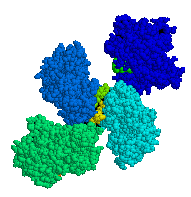Peroxisome proliferator-activated receptor
|
|
| Contents [hide] |
Nomenclature
Three types of PPARs have been identified: alpha, gamma and delta (beta).
- α (alpha) - expressed in kidney, heart, muscle, adipose tissue, and others.
- γ (gamma) - although transcribed by the same gene, this PPAR exists in three forms:
- γ1 - expressed in virtually all tissues, including heart, muscle, colon, kidney, pancreas and spleen.
- γ2 - expressed mainly in adipose tissue (30 aminoacids longer)
- γ3 - expressed in macrophages, large intestine, white adipose tissue.
- δ (delta) - expressed in many tissues but markedly in brain, adipose tissue and skin.
History
PPARs were discovered during the search of a molecular target for a group of agents then referred to as "peroxisome proliferators", as they increased peroxisomes in rodent liver tissue, apart from improving insulin sensitivity. These agents, pharmacologically related to the fibrates, had been discovered in the early 1980s. When it turned out that PPARs played a much more versatile role in biology, the agents were in turn termed "PPAR ligands". The best-known PPAR ligands are the thiazolidinediones; see below for more details.
What happened to PPARβ (beta)?
After PPARδ (delta) was identified in humans in 1992, it turned out to be identical to the PPARβ (beta) previously described during the same year in other animals (Xenopus). The name PPARδ is generally used to the exclusion of PPARβ.
Physiological function
All PPARs dimerize with the retinoid X-receptor (RXR) and bind to specific regions on the DNA, termed PPREs (peroxisome proliferator response elements). The DNA consensus sequence is AGGTCAXAGGTCA with X being a random nucleotide. Generally, this sequence occurs in the promotor region of a gene, and when the PPAR is activated, transcription is increased (a number of genes is, however, suppressed by PPARs). The RXR also forms a heterodimer with a number of other receptors: the vitamin D receptor and the thyroid hormone receptor.
The function of PPARs is modified by the exact shape of their ligand-binding domain (see below) and by a number of co-activators and co-repressors, the presence of which can stimulate or inhibit receptor function. Insulin appears to be an important cofactor, through activation of the insulin receptor.
The ligands for the PPARs are free fatty acids and eicosanoids. PPARγ is activated by PGJ2 (a prostaglandin). In contrast, PPARα is activated by leukotriene B4.
Genetics
The three main forms are transcribed from different genes:
- PPARα - chromosome 22q12-13.1 (OMIM 170998 (http://www.ncbi.nlm.nih.gov/entrez/dispomim.cgi?cmd=entry&id=170998)).
- PPARγ - chromosome 3p25 (OMIM 601487 (http://www.ncbi.nlm.nih.gov/entrez/dispomim.cgi?cmd=entry&id=601487)).
- PPARδ - chromosome 6p21.2-21.1 (OMIM 600409 (http://www.ncbi.nlm.nih.gov/entrez/dispomim.cgi?cmd=entry&id=600409)).
Hereditary disorders of all PPARs have been described, generally leading to a loss in function and concomitant lipodystrophy, insulin resistance and/or acanthosis nigricans. Of PPARγ, a gain-of-function mutation has been described and studied (Pro12Ala) which decreased the risk of insulin resistance; it is quite prevalent (allele frequency 0.03 - 0.12 in some populations). In contrast, pro115gln is associated with obesity. Some other polymorphisms have high incidence in populations with elevated body mass indexes.
Structure
All PPARs have a basic structure of functional domains. The most important ones are the DBD (DNA binding domain) and the LBD (ligand binding domain). The DBD contains two zinc finger patterns which bind to the regulator region of DNA when the receptor is activated. The LBD has an extensive secondary structure of several alpha helices (13) and a beta sheet. Natural and synthetic ligands bind to the LBD, activating the receptor.
Pharmacology
PPARα and PPARγ are the targets of a number of known medications and are under continuing research for other forms of pharmacological modulation.
PPAR-alpha
PPAR-alpha is the main target of fibrate drugs, a class of amphipathic carboxylic acids (clofibrate, gemfibrozil and others). They are used in cholesterol disorders (generally as an adjunctive to statins) and disorders that feature high triglycerides.
PPAR-gamma
PPAR-gamma is the main target of the drug class of thiazolidinediones, used in diabetes mellitus and other diseases that feature insulin resistance. It is also mildly activated by certain NSAIDs (such as ibuprofen) and indoles. Known inhibitors include the experimental agent GW-9662.
See also
Sources
- Berger J, Moller DE. The mechanism of action of PPARs. Annu Med Rev 2002;53:409-35. PMID 11818483.
External links
- PPAR resource (http://www.cas.psu.edu/docs/CASDEPT/VET/jackvh/ppar/pparrfront.htm) (Penn State University).
- PPAR reference outline (http://www.rci.rutgers.edu/~gray/Framed%20Nuclear%20Receptor%20outline/Main%20outline%20page.htm) (Rutgers).ja:PPAR

